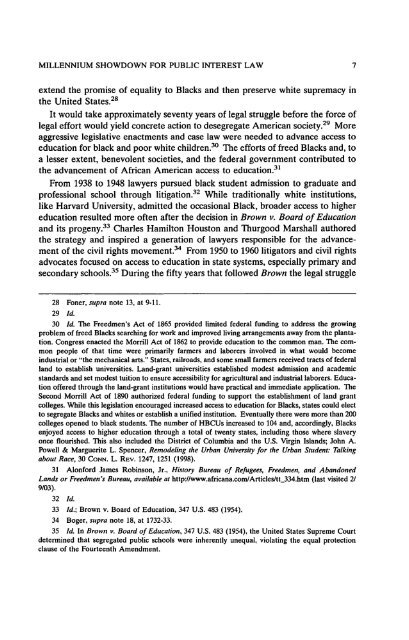Download Electronic Version - UDC Law Review
Download Electronic Version - UDC Law Review
Download Electronic Version - UDC Law Review
Create successful ePaper yourself
Turn your PDF publications into a flip-book with our unique Google optimized e-Paper software.
MILLENNIUM SHOWDOWN FOR PUBLIC INTEREST LAW 7<br />
extend the promise of equality to Blacks and then preserve white supremacy in<br />
the United States. 28<br />
It would take approximately seventy years of legal struggle before the force of<br />
legal effort would yield concrete action to desegregate American society.29 More<br />
aggressive legislative enactments and case law were needed to advance access to<br />
education for black and poor white children. 3D The efforts of freed Blacks and, to<br />
a lesser extent, benevolent societies, and the federal government contributed to<br />
the advancement of African American access to education?1<br />
From 1938 to 1948 lawyers pursued black student admission to graduate and<br />
professional school through litigation. 32 While traditionally white institutions,<br />
like Harvard University, admitted the occasional Black, broader access to higher<br />
education resulted more often after the decision in Brown v. Board of Education<br />
and its progeny.33 Charles Hamilton Houston and Thurgood Marshall authored<br />
the strategy and inspired a generation of lawyers responsible for the advancement<br />
of the civil rights movement. 34 From 1950 to 1960 litigators and civil rights<br />
advocates focused on access to education in state systems, especially primary and<br />
secondary schools. 35 During the fifty years that followed Brown the legal struggle<br />
28 Foner, supra note 13, at 9-11.<br />
29 Id.<br />
30 Id. The Freedmen's Act of 1865 provided limited federal funding to address the growing<br />
problem of freed Blacks searching for work and improved living arrangements away from the plantation.<br />
Congress enacted the Morrill Act of 1862 to provide education to the common man. The common<br />
people of that time were primarily farmers and laborers involved in what would become<br />
industrial or "the mechanical arts." States, railroads, and some small farmers received tracts of federal<br />
land to establish universities. Land-grant universities established modest admission and academic<br />
standards and set modest tuition to ensure accessibility for agricultural and industrial laborers. Education<br />
offered through the land-grant institutions would have practical and immediate application. The<br />
Second Morrill Act of 1890 authorized federal funding to support the establishment of land grant<br />
colleges. While this legislation encouraged increased access to education for Blacks, states could elect<br />
to segregate Blacks and whites or establish a unified institution. Eventually there were more than 200<br />
colleges opened to black students. The number of HBCUs increased to 104 and, accordingly, Blacks<br />
enjoyed access to higher education through a total of twenty states, including those where slavery<br />
once flourished. This also included the District of Columbia and the U.S. Vrrgin Islands; John A.<br />
Powell & Marguerite L. Spencer, Remodeling the Urban University for the Urban Student: Talking<br />
about Race, 30 CONN. L. REV. 1247, 1251 (1998).<br />
31 Alonford James Robinson, Jr., History Bureau of Refugees, Freedmen, and Abandoned<br />
Lands or Freedmen's Bureau, available at http://www.africana.comlArticlesltc334.htm (last visited 21<br />
9/03).<br />
32 Id.<br />
33 Id.; Brown v. Board of Education, 347 U.S. 483 (1954).<br />
34 Boger, supra note 18, at 1732-33.<br />
35 Id. In Brown V. Board of Education, 347 U.S. 483 (1954). the United States Supreme Court<br />
determined that segregated public schools were inherently unequal. violating the equal protection<br />
clause of the Fourteenth Amendment.














